
8 Best Tankless On-Demand RV Water Heaters
You’re in your RV and it’s been a long day, or you have friends and family with you, or you get over chilled…there are plenty of instances when there’s nothing worse than running out of hot water.
And, given that a standard hot water heater in most RVs can only hold 6 or 10 gallons of water, this happens with alarming frequency. Fortunately for you, it doesn’t have to. One more and more common option helps ensure you won’t ever run out of hot water again (at least not as long as you can power your heater): tankless hot water heaters.
Not only do tankless hot water heaters ensure that you always have hot water in your RV, but they also produce hot water exactly when you need it.
Let’s look at how they work and a few of our favorites.
Table of Contents
How Do Tankless Water Heaters Work?
Tankless or on-demand water heaters work by simply heating the water instantly as it flows through the unit. Installation varies, but in general, they are done in-line. That is, water flows into the tankless heater, is heated as it flows through the device, and then flows out via a separate line.
Some on-demand water heaters are mobile and can be used in or out of an RV. Others need to be installed, similar to a normal water heater. The important distinction here is that, unlike traditional water heaters, tankless models heat water near instantly in its normal flow, rather than needing to store a bunch of water in a tank — heating that water, then replacing that water and heating the replaced water. As a result, you have a constant supply of hot water, or as constant as you keep your tankless water heater powered, anyway.
If you are looking into buying a tankless water heater, first let us say congratulations. Not only are tankless on-demand water heaters smaller, lighter, and more energy-efficient, but they also help save fuel and can, depending on how you use them, keep weight down in your RV, as you won’t have standing water in a hot water heater.
What Size Tankless Water Heater Do You Need?
That said, it’s important to know your water usage as that will determine which tankless system will work best for you. Most showers use between 1-3 gallons of water per minute, toilets may be between a half-gallon and 2 gallons per flush, and your kitchen sink likely uses 1-2 gallons per minute. In other words, depending on how you use water in your RV, your consumption can add up quickly.
Not all on-demand water heaters supply water at the same rate, of course, but many supply somewhere between 2-6 gallons per minute, depending on the model. Another consideration is the water capacity of your RV. If your freshwater tank is only 12 gallons, for instance, you may not want a water heater that can spit out 6 gallons of hot water per minute, to take an extreme example.
Most users really are interested in tankless RV water heaters for better showers, if we’re being honest, and you need to quantify the flow rate and water pressure needed for an enjoyable shower. For many people, that’s 2-3 gallons of hot water per minute – but it may be more or less, depending on your individual preferences.
How Much do Tankless Water Heaters Cost?
Tankless water heaters vary widely in price. A general range might be $500-$1,000, but there are tankless water heaters on this list that can be found for less, just as some of them may cost more. And these costs will not include installation (which may require a professional) or any additional parts needed to make them work in your RV, so be smart about your budget and do the research before buying anything.
Do Tankless Water Heaters Save Money and are They Worth it?
Even though the initial cost of getting a tankless demand-type water heater is higher than getting a tank, the difference is not huge. They do save you some money over the long run , and Energy.gov estimates energy savings of about 8-14%. They also last about 5-10 years longer and don’t have as many operating costs as storage heaters. If you live in the right state, you may also qualify for rebates or tax credits if the heater meets efficiency requirements. So overall, I would say yes to both these questions- they do save you some money and if you are environmentally friendly, they are worth it.
Pros & Cons of Tankless On Demand Water Heaters
Like anything, there are pros and cons of getting a demand-type water heater.
PROS:
- Energy efficiency
- Use 50% less propane (if you have propane heater), so you don’t run out as fast
- Lower operating costs
- Take up much less space than tanks
- Constant flow of water
- No need for storage tank (or winterizing it)
- Less risk of spillage
CONS:
- If it is not installed properly it may waste water
- The water temperature may not be as stable and some models are known to have issues with keeping a constant water temperature
- Higher initial cost
What to Keep in Mind Before Getting one?
First of all, think about where you will be using the water heater. Some models do better with colder water than others, and some are designed with winter in mind while others are not. Your individual needs may require more or less BTUs. While most demand-type water heaters are capable of 30,000 – 50,000 BTUs per hour, you may desire more if you want something that resembles your shower at home.
Similarly, note the power source you’re most comfortable using. Most of these tankless water heaters are propane (often with battery-driven igniters), but there are electric models available, should that be a consideration. In much the same way, keep in mind the space you have available in your RV for such a unit.
You may be able to convert your current water heater to a tankless system, but be forewarned that doing so may require some serious planning and work, including potentially hiring a professional to help with the conversion.
How to Install an On-Demand Tankless Water Heater?
Installing a demand-water heater is a very variable experience, depending on the model and the space in which you are attempting to install the unit. I recommend getting professional help, hiring someone with express experience in installing tankless water heaters who is capable of adhering to local codes regarding the plumbing, electric, gas, and venting of your RV.
Once installed, however, using your tankless water heater is generally pretty simple. Check the bypass valve, open it, allow water to flow into the primary tank, then connect your RV to a water source. Using an on-board pump, begin pumping water. Turn the hot water tap on, so that water can begin flowing through the heating tank’s line, being sure to let it fully fill. And voila! You’re in business. It really can be that simple.
Really, finding a good tankless water heater should not be that hard. Simply do the research so you know what you’re looking for. To recap: you need to know how much water you plan on using, what space you have available, and what kind of flow rate and power you hope to utilize. Once you’ve drawn some basic conclusions, you may be surprised at how quickly you can start working through your options to draw up a short list of tankless water heaters that will work for you.
Remember to work with professionals when installing your new heater, and just like that, you can look forward to much better showers!
Our 8 Picks of Best Tankless Water Heaters
With all that said, on to some of our favorites:
1. Camplux 5L portable propane tankless water heater
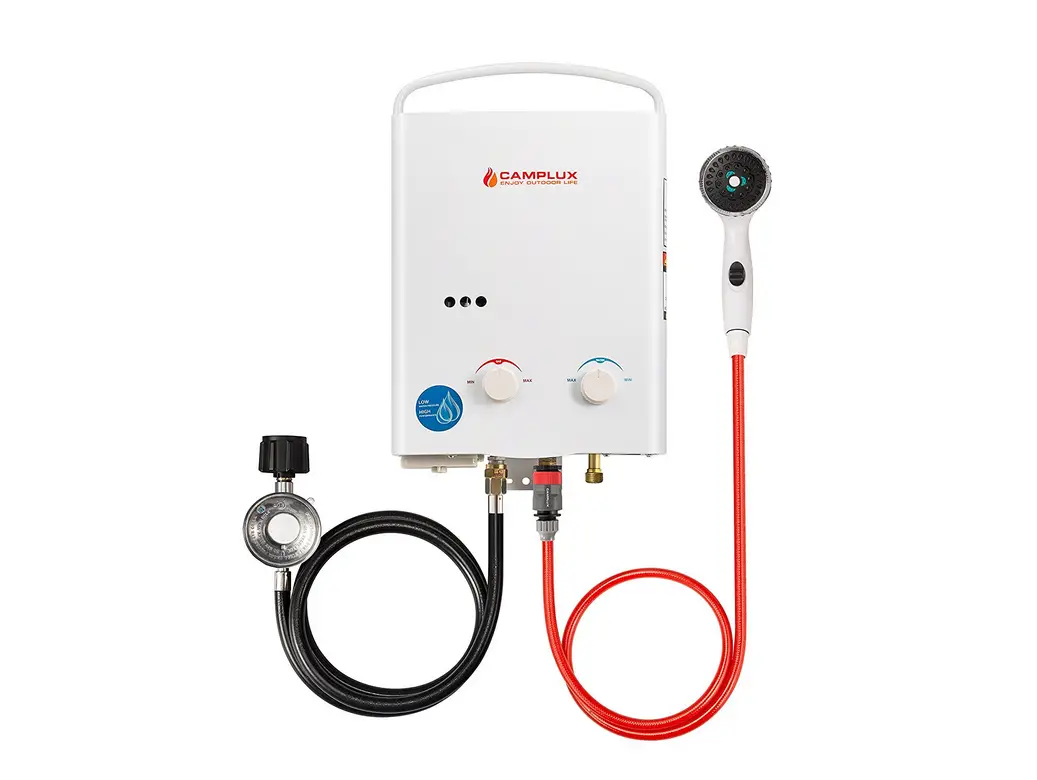 With the Camplux 5L model, you can install it where you would a normal hot water heater, or if it’s nice weather and you feel like taking an outdoor shower, you can do that, too. All you need is propane access. It has the added advantage of an adjustable flow rate and uses less fuel than many comparable units. Two brass knobs control the heat and flow rate, and the fact that it runs on propane means it will work well off-grid. One drawback, however, is that it can be difficult to drain.
With the Camplux 5L model, you can install it where you would a normal hot water heater, or if it’s nice weather and you feel like taking an outdoor shower, you can do that, too. All you need is propane access. It has the added advantage of an adjustable flow rate and uses less fuel than many comparable units. Two brass knobs control the heat and flow rate, and the fact that it runs on propane means it will work well off-grid. One drawback, however, is that it can be difficult to drain.
This tankless water heater is a compact unit that comes with a foldable handle, making it easy to carry around or hang on a pole. As a portable heater, it is fueled by propane gas and uses two D cell batteries to ignite the burners. There are no batteries included in the box, but at its price point, you can justify getting it separately.
This model is designed for outdoor use but you can also install it indoors if there is proper ventilation, so carbon dioxide doesn’t build up to toxic levels. There are also mounting brackets at the top and bottom, and it’s easy to reach the screw holes with a screwdriver. A drawback of this particular unit is that even with slight wind, the burners easily die. It’s almost useless in a higher elevation where the wind is even stronger.
It is important to note that you can’t use the heater in a horizontal position or the burners die. The foldable hanger makes it rather convenient for hand-held use or you can hang the unit in a suitable safe place. However, because the heat vents from the top, the handle can get too hot and you can’t move the unit right after use.
When plumbing water through the unit, the water lines use ½” BSP, and it’s annoying that you still have to buy an adapter for NPT fittings. Washers may also be necessary since some users have seen water leaking when the heater is not in use.
On the good side, a gas regulator, hose, and shower head are included in the box so you can use the unit right away. There is also a drain plug, since you will have to drain the water every time you use it, so frozen water doesn’t damage the pipes.
With your plumbing done, a starting pressure of 2.5 psi is reasonably low, but even a small water pump will improve flow, especially if you use stagnant water sources. As long as the pressure is consistent, it is easy to manipulate the desired temperature of the hot water. There is no thermostat readout, though, so you will have to wait and see every time you use it.
Like with other portable tankless water heaters, there is a time limit of continuous hot water up to 20 minutes, which may not be enough. However, turning it off before the time limit is over usually resets the timer and you have another 20 minutes of non-stop hot water. Also, compared to other popular heaters, it is a smaller size unit and has a lower output rate. For a higher output, Camplux offers bigger models, but you lose out on portability.
PROS
- Comes with a foldable handle
- A shower head, hose, and gas regulator are included in the box
- Low starting pressure of 2.5 psi
- Comes with freeze protection for winter use
CONS
- The top of the unit gets hot to the touch
- Burners die in a slight wind
- No thermostat readout
- Fittings are not standard for American users
- Time limit of 20 minutes for continuous hot water
2. Camplux 10L 2.64GPM Outdoor Portable Tankless Water Heater
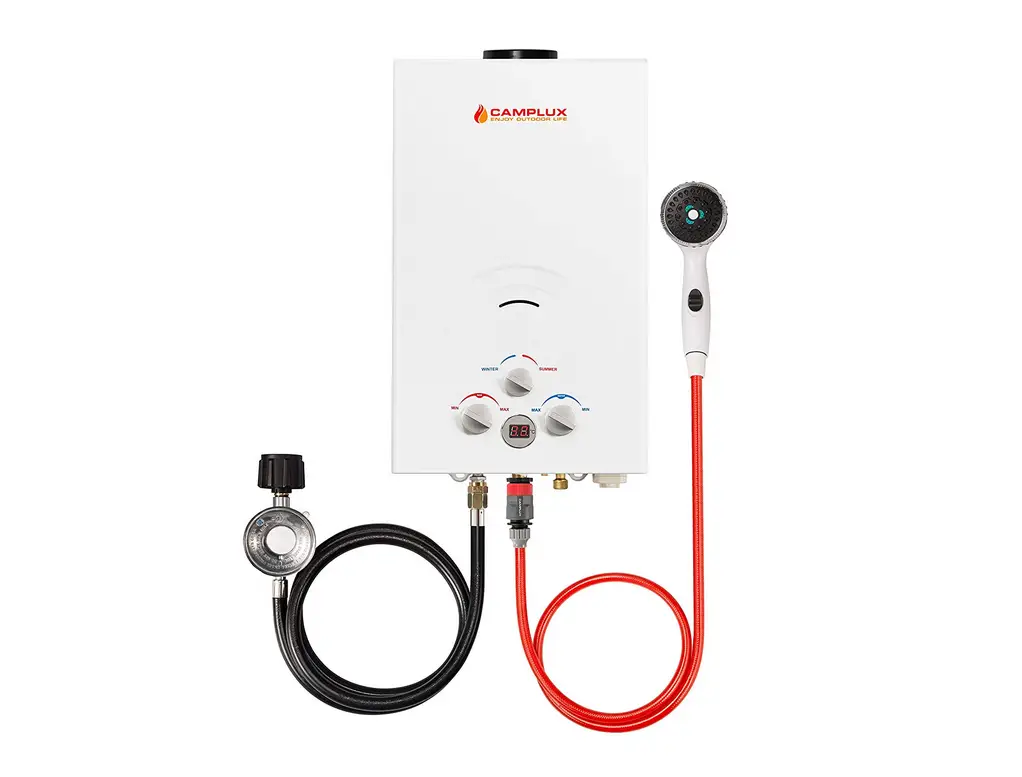 This tankless water is the larger version of the previous Camplux model and it is a 10l one. The heater is fueled by propane gas to heat water and uses a pair of D cell batteries for ignition. Designed primarily for outdoor use, it has an exhaust vent at the top, but there is no rain cap included in the box. And unlike its smaller siblings, there is no foldable handle, which is a bummer since even at this size it can still be lugged around.
This tankless water is the larger version of the previous Camplux model and it is a 10l one. The heater is fueled by propane gas to heat water and uses a pair of D cell batteries for ignition. Designed primarily for outdoor use, it has an exhaust vent at the top, but there is no rain cap included in the box. And unlike its smaller siblings, there is no foldable handle, which is a bummer since even at this size it can still be lugged around.
When mounting the unit to a wall, the screw holes at the bottom are easy to access, but the top mounting bracket makes it hard to reach with a screwdriver. There is enough space, however, for air to circulate at the back once the unit is mounted. When installing the heater indoors, you will have to attach a flue vent or ensure the room has proper ventilation.
In plumbing fluids through the unit, the water lines use a ½” BSP, and while it’s not the most used standard, there are adapters for NPT fittings in the box. A hose, shower head, and gas regulator are included, which is very great. The Full/Eco knob allows you to control the propane, depending on the temperature of the input; and it’s helpful in maximizing fuel usage.
There is also a drain plug and removing the water inside takes no time at all. You’ll want to avoid frozen water inside as it is paramount for the longevity of the heater.
With all the pipes connected, you can run the unit at a starting pressure of 3.6 psi, more than enough if your source is a faucet with a strong flow. Gravity-fed sources, however, will still greatly benefit from a water pump. When pressure is consistent, it takes a few moments for hot water to come out. Thankfully, there is a thermostat readout unlike the other cheaper model, so it’s easy to see how hot the output will be.
There is a time limit of 20 minutes for an uninterrupted flow of hot water, but once again you can bypass this if you turn off the unit before the end of this period and turn it on again. If you’re someone who turns off the water when not in uses, this isn’t really a deal breaker.
PROS
- Full/Eco knob helps conserve propane
- Comes with a thermostat readout
- Easy to empty the water inside with the drain plug
- Low-starting pressure of 3.6 psi
- Shower head, hose, gas regulator, and adapters included in the box
CONS
- No handle
- No rain cap in the box
- Top mounting bracket is hard to reach with a screwdriver
- Hot water takes a few moments
- 20 minute time limit of continuous hot water
3. Eccotemp L10 Propane Portable Tankless Water Heater
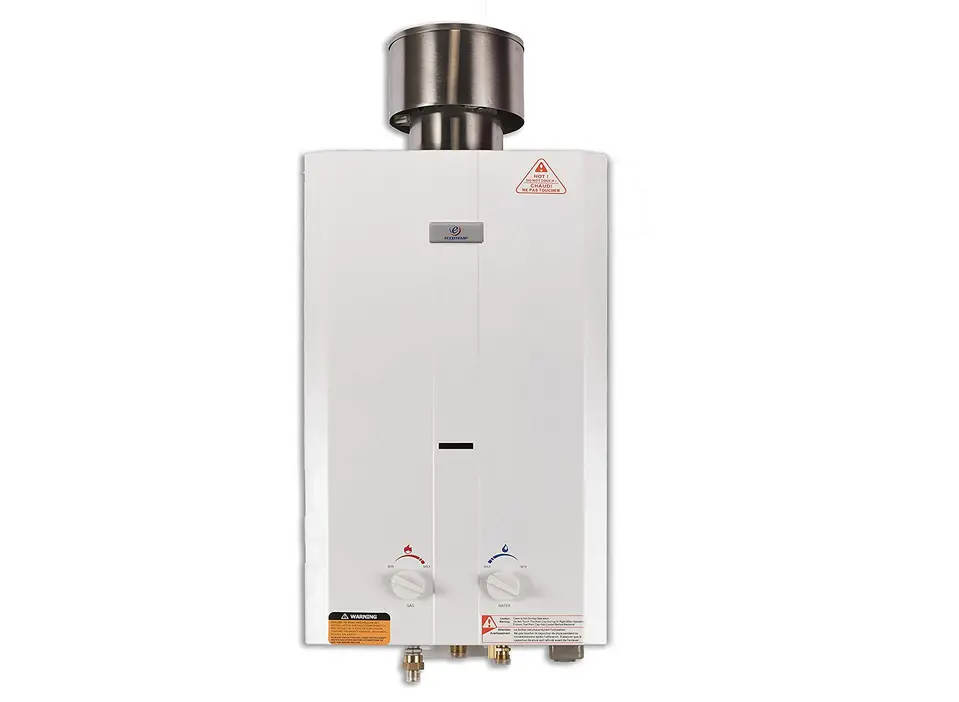 Like the Camplux 5L, the Eccotemp L10 is nicely portable and has the added advantage of only running when you want it to, as opposed to the many tankless water heaters that run intermittently as needed. Its rugged design and easy portability also mean that when camping in remote areas, it’s incredibly easy to set up an outdoor shower, should you so choose. It is, however, heavier than some portable units.
Like the Camplux 5L, the Eccotemp L10 is nicely portable and has the added advantage of only running when you want it to, as opposed to the many tankless water heaters that run intermittently as needed. Its rugged design and easy portability also mean that when camping in remote areas, it’s incredibly easy to set up an outdoor shower, should you so choose. It is, however, heavier than some portable units.
This tankless water heater uses propane gas for the burners and two D-cell batteries for ignition. There are no batteries included, although but the rain cap in the box is a big plus. When your heater is set up outdoors and rain can easily get into it, this cap is a real a lifesaver.
Designed primarily for outdoor use, it is portable, but I wish it had a handle instead of just grabbing it by the mounting bracket. I also really like that the screw holes are easy to reach with a screwdriver, they are more than half an inch further from the back and there is enough space when mounted on a wall for air to circulate.
In setting up the flow of water through the unit, you will have to rely on a pressurized input since there is no pump in the system. The starting pressure of 20 psi will almost always require a pump if your water source isn’t as pressurized as a garden faucet.
No shower head and hose is included, but the fittings are ½” NPT, which is widely used. There are also adapters and quick connects in the box, and you can use just about any brand of shower head and hose. There is a gas regulator too and you can use a 20-lb propane tank or bigger with no problem.
With a stable input of water, you control the flow and heat together to achieve your desired output. It’s a bummer, however, that there is no thermostat and you will have to guess the temperature. There is no form of freeze protection, so you will have to drain the unit manually every time you use it in the winter. It works well in high altitudes of about 4000 feet, but be wary of the wind since the burners can die in strong gusts. Also, keep in mind that the unit automatically shuts off after 20 minutes of an uninterrupted flow of hot water.
PROS
- Screw holes are easy to reach with a screwdriver
- Rain cap and gas regulator included in the box
- Easy to attach any brand of shower head and hose
- Hot water time limit resets when restarting the unit
CONS
- No batteries in the box
- No handle
- Pressurized input is needed for the burners to ignite
- No thermostat
- Hot water only runs for 20 minutes
- No shower head in the box
4. Excel Propane Tankless Water Heater
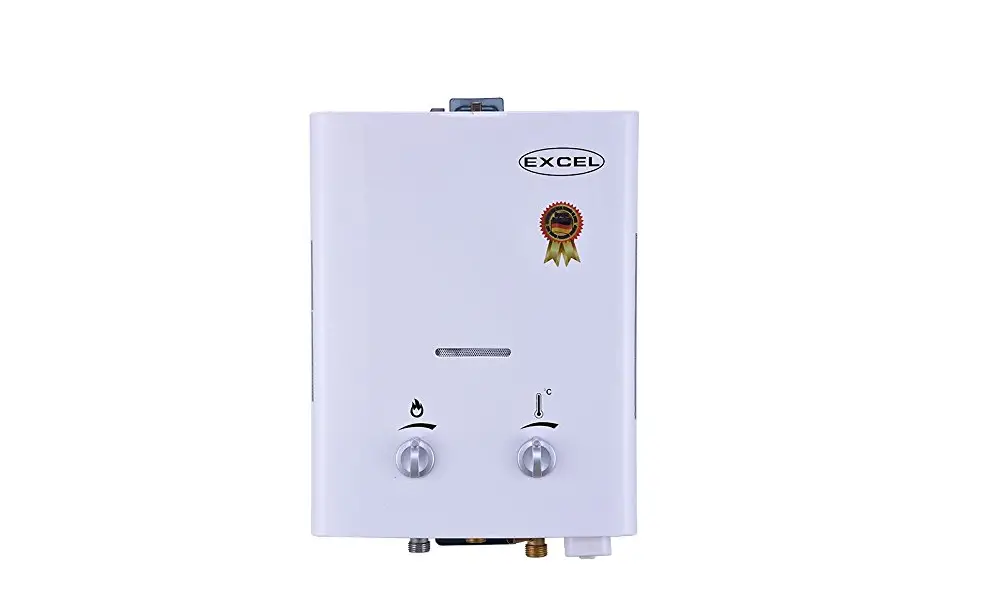 Just 2 psi is enough to work with this Excel water heater, and it works all the way up to 120 psi, meaning that it has a much wider range of applicable water pressures than most tankless heaters. It struggles with water colder than 50 degrees (although it can work all the way down to 40 degrees at a lower flow rate), but it’s well-reviewed, well-designed, and for some, the range of water pressure is a selling point in and of itself. It can, however, be difficult to install.
Just 2 psi is enough to work with this Excel water heater, and it works all the way up to 120 psi, meaning that it has a much wider range of applicable water pressures than most tankless heaters. It struggles with water colder than 50 degrees (although it can work all the way down to 40 degrees at a lower flow rate), but it’s well-reviewed, well-designed, and for some, the range of water pressure is a selling point in and of itself. It can, however, be difficult to install.
This tankless water heater uses propane gas, but it produces no flue gas, unlike conventional water heaters. The proprietary technology implemented by Excel is such that the exhaust gas from the combustion is converted to carbon monoxide and water vapor. The unit produces no smoke and, in a sense, is friendly to the environment. It is powered by a pair of D-cell batteries that are included in the box. I found it to be a neat little convenience for the first time using the unit.
While you can mount the unit indoors or outdoors, the top can get very hot since that’s where the heat exchange happens. It is vital to install it in a place with proper ventilation. And because it produces carbon monoxide, excessive build up indoors can be poisonous, and you might have to get a detector for use in confined spaces.
Excel recommends installing this unit upright for proper operation. Its compact size should make it easy to place it just about anywhere, and the mounting holes have a decent allowance from the back to allow air to circulate.
When plumbing the system, you will need at least two psi of pressure for the input, and it’s low enough for gravity-fed sources as long as the flow of water is consistent. This makes it quite convenient, especially if you switch between different water sources frequently, and water pressure is inconsistent at times. As there is no freeze protection, using it during the winter months requires the extra effort of manually draining it to avoid damage.
There is no shower head or hose in the box, but it does come with standard ½” NPT fittings, so you can attach any brand of hose or shower you like. There is no gas regulator or thermostat in the box, only a brass adapter.
The low starting pressure allows the unit to work at high altitudes, and it’s rather mind-boggling that some users claim to use this heater at 7000 feet with no problems whatsoever.
As with several other heaters, this the system has a timer of 20 minutes before it shuts off.
PROS
- Doesn’t produce smoke
- Includes two D-cell batteries
- Low starting pressure of 2 psi
- Works at high elevations
- Easy to attach any brand of shower head and hose
CONS
- Watch out for excess carbon monoxide when used indoors
- The top can get very hot during operation
- No thermostat
- Hot water only runs for 20 minutes
- No shower head, hose, and gas regulator in the box
5. EZ 202 portable propane tankless water heater
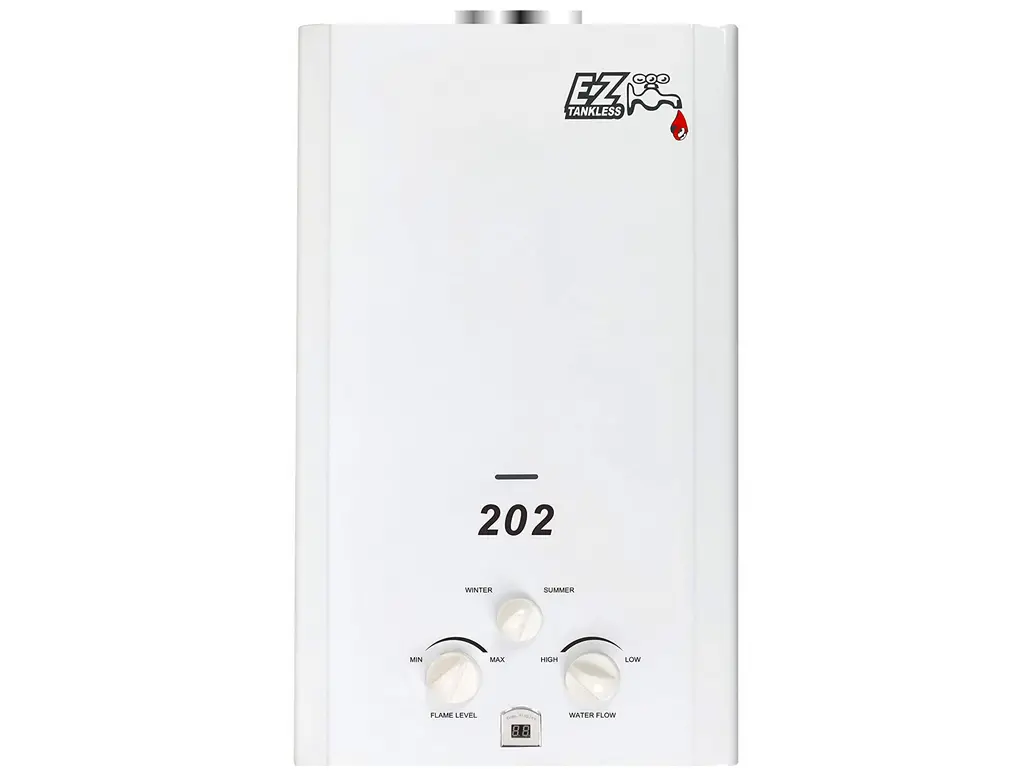 Like the Eccotemp L10, the EZ 202 is a highly portable heater. However, I wish it came with a handle because it would be so much easier to carry around. It’s easy to use, although some users have reported difficulties with the setup process. Mostly because when mounting it on a wall, the mounting brackets at the top are harder to reach with a screwdriver.
Like the Eccotemp L10, the EZ 202 is a highly portable heater. However, I wish it came with a handle because it would be so much easier to carry around. It’s easy to use, although some users have reported difficulties with the setup process. Mostly because when mounting it on a wall, the mounting brackets at the top are harder to reach with a screwdriver.
This tankless heater uses propane gas to heat water and is powered by a pair of D-cell batteries (not included in the box).
EZ202 has several vents at the bottom so air can easily pass through the unit. The downside, however, is that windy conditions will extinguish the flame quickly. The unit doesn’t come with a rain cap, so if you plan to use it outside, you will need something to cover the exhaust vent. You will also have to vent the flue gas outside if you decide to use the unit indoors. It uses propane efficiently and has one of the higher flow rates for portable units: up to 3.2 gallons per minute.
When plumbing your unit, a neat little feature is that the water inlet and outlet fittings are made of brass, while the gas inlet is steel. This makes it easier to distinguish the water line from the gas line. For water input, while the starting pressure is quite low at 2.9 psi, a small pump is needed if your gravity-fed system doesn’t have a consistent flow of water. For places without a nearby faucet, it is best to have a backup water pump just in case.
The fittings for the water line use a ½” NPT, and there is a shower head or hose included in the box. There is no gas regulator either, and given the price, this is rather disappointing, I must say. Fortunately, there is a thermostat readout (unlike some other cheaper models).
The Winter/Summer knob allows you to limit your propane usage, depending on the temperature of the input. It is helpful in conserving gas, especially during summer when you really don’t need much gas to heat water that is already warm.
Upon turning on the unit, if you want hot water to come out right away, simply increase the flame and reduce the flow slightly. When your hot water is going, you have 20 minutes before the system shuts off to prevent overheating. If you need hot water for more than this, turn the unit off and then turn it on again. It also important to note that when the temperature exceeds 190 degrees Fahrenheit (88 degrees Celsius), the heater will automatically shut off.
PROS
- Water and gas lines are easily distinguishable
- Low starting pressure of 2.9 psi
- Comes with a thermostat readout
- Comes with a shower head and hose
CONS
- No batteries included
- Prone to dying out in windy situations
- No rain cap and gas regulator in the box
- Hot water only runs for 20 minutes
6. Girard 2GWHAM Propane Tankless Water Heater
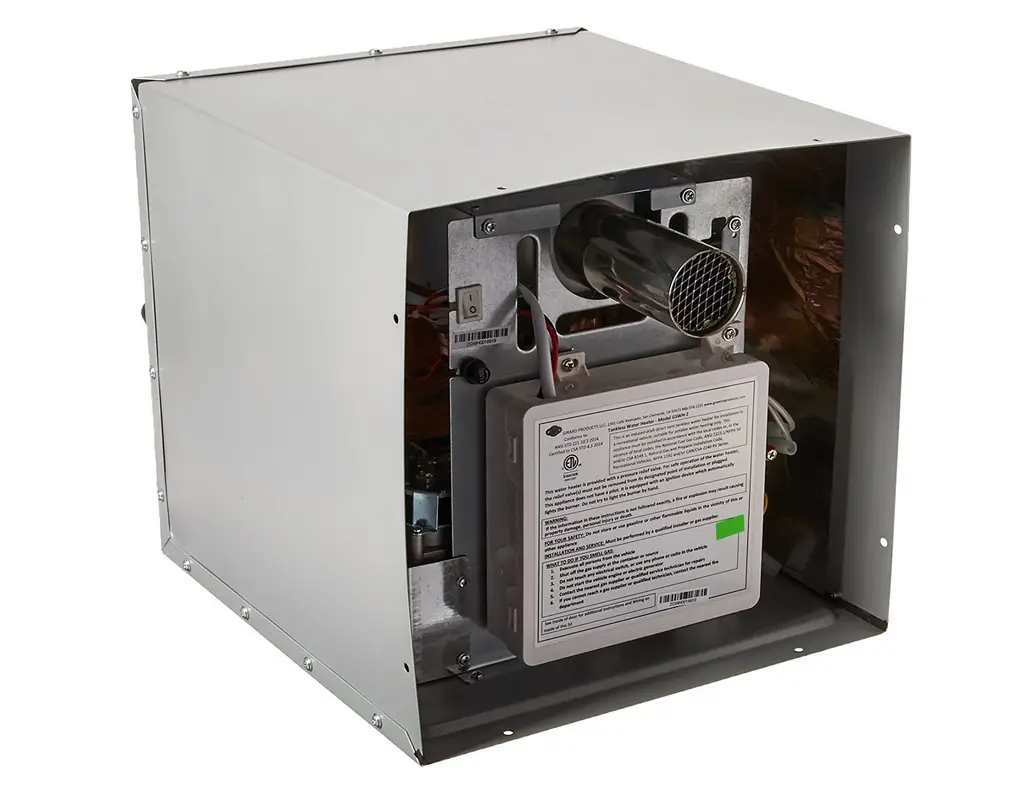
This updated cousin of the 1GWHAF is a much stronger version for those who need more power. It’s much better suited for four-season use, with its freeze protection ability. And noting the noise reported in the 1GWHAF, the 2GWHAM is much, much quieter. It doesn’t require any special lines, runs on propane, and is automatically self-regulating. It does, however, require separately purchased mounting equipment.
This tankless heater is a replacement for a six-gallon tank water heater located at the side of an RV. Fortunately, Girard offers adapters for popular brands like Atwood and Suburban water heaters, and they also sell the unit’s door depending on the make and model of your RV. You will have to order the door separately from Girard’s website.
The unit is fueled by propane gas, and you need to wire it to a 12V power source. You get a digital controller in the box that allows you to control the temperature, but you can’t control the speed of the cooling fan, which is still fairly loud when the heater is running (although not as loud as the previous model). It can be heard even outside the RV, which can be annoying when you have the heater running all day.
When installing the unit, replacement is pretty straightforward, but there is one difference in the wiring, especially when you are replacing an Atwood unit. Only use the brown wire when wiring the controller instead of both the blue and brown wires. As it turns out, the blue wire is for another light indicator for the control panel instead of being the ground connection.
When plumbing the unit, the water line has a ½” NPT fitting, and the control valve for water input is a welcome addition. The gas line use a ⅜” flare fitting instead of a compression fitting, like it says in the manual. For anyone who does not know that a compression fitting is not ideal for a gas line, the manual can be misleading.
Like smaller and more portable tankless water heaters, the continuous flow of hot water is only good for 20 minutes. For a larger unit, this doesn’t seem to be enough. Turning it off before 20 minutes is over and then turning it on again seems to work, but this adjustment is easy to forget.
Do keep in mind that when using the sink and shower together, the unit can’t keep up with the volume if the temperature goes beyond 95 degrees Fahrenheit. For someone who likes their water warmer than 95 degrees, it is disappointing that you can’t use hot water for both the sink and shower at the same time.
Since this unit is not intended for portability and is more exposed in a cold weather than smaller water heaters, there is freeze protection so the heater can still be used during the winter. As we all know, during those freezing blizzards, especially in higher altitudes, having access to instant hot water is a lifesaver.
PROS
- Direct replacement for Atwood and Suburban water heaters
- Girard offers the specific replacement door depending on your RV
- Comes with a digital controller
- Comes with freeze protection
CONS
- The cooling fan is loud and you can’t control speed
- Gas line uses flare fittings and the manual doesn’t correctly specify this
- Continuous hot water is only good for 20 minutes
- The unit can’t provide water hotter than 95 degrees Fahrenheit for multiple purposes
7. PrecisionTemp RV-550 tankless water heater
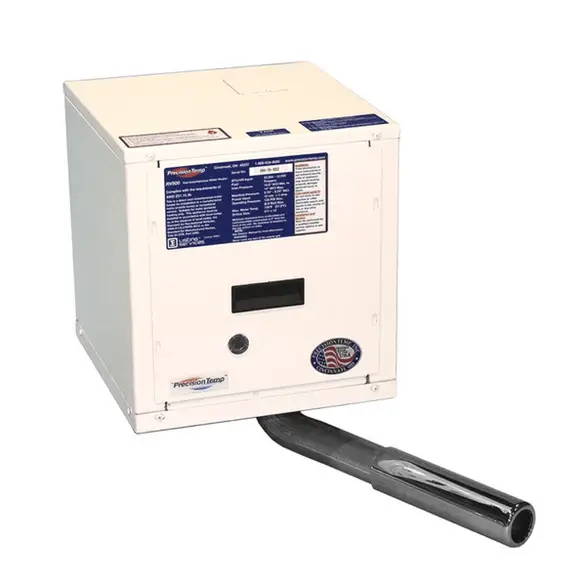 While one of the more expensive units out there, the RV-550 pays the cost off in time by being incredibly efficient. A 20-pound propane tank, for instance, can heat 940 gallons of water. Additionally, it has the added advantage of being small and light (half the size and one-third the weight of a more standard 10-gallon water heater) and can be used in more than just your RV; it’s often used in tiny homes, for instance. At 1.5 gallons per minute of flow rate, it gives a great shower, and it’s quiet, too. Really, the only drawback is the price.
While one of the more expensive units out there, the RV-550 pays the cost off in time by being incredibly efficient. A 20-pound propane tank, for instance, can heat 940 gallons of water. Additionally, it has the added advantage of being small and light (half the size and one-third the weight of a more standard 10-gallon water heater) and can be used in more than just your RV; it’s often used in tiny homes, for instance. At 1.5 gallons per minute of flow rate, it gives a great shower, and it’s quiet, too. Really, the only drawback is the price.
This tankless water heater is a direct replacement for a 10-gallon tank water heater that connects to the power source of your RV and uses propane gas to heat the water. The PrecisionTemp also offers adapter mounts depending on how big the heater compartment is in your RV.
When installing it, take note that the unit is tapered from front to back. I know a fellow camper who swapped out his Atwood 6 gallon unit but measured the back only. In his first attempt to insert the heater, the hole needed to be bigger, so he had to match it with the front. And while it is a replacement for a 10-gallon water heater, it’s also a slightly smaller unit, so there’s a gap inside the hole. Nothing that a few wood spacers can’t fix.
You can order the door in a raw metal finish aside from the standard white color. PrecisionTemp says you can even specify a color to match your RV — of course with an additional charge.
After mounting the heater, the wires are in a different color scheme, but the manual is thorough on how to connect to the existing controller. Unlike the Girard 2GWHAMk, though, you don’t get a new controller, and you also don’t get a thermostat readout. This is inconvenient at best,,, but it does have automatic freeze protection (thermostat detects 38 degrees Fahrenheit of input).
When plumbing water through the system, the water line uses ½” NPT fittings while the gas line uses a 3/8” flare fitting. Unlike the Girard unit, however, you don’t get a valve to control water input. I don’t find this to be a deal breaker since flow valves are easy to add to the plumbing.
Since it is reliant on water pressure to operate correctly, it takes a while to get a continuous flow of hot water if the input pressure is fluctuating. It’s almost useless in campgrounds where the pressure can get low during peak hours, and it is frustrating when it just shuts down. When you get things going, I suggest that you open the hot water output fully and control the input of colder water by dialing the desired temperature.
As long as the pressure is consistent, you get to enjoy hot water as long as you want. There is practically no time limit for continuous hot water, unlike other units that tends to shut down after 20 minutes. This is probably its biggest advantage; plus it works at higher elevations where winters are colder and windier.
However, when you start the system at a very cold input temperature, i.e. below 38 degrees Fahrenheit, it immediately shuts off. PrecisionTemp suggests you don’t exceed more than a pint when adding anti-freeze.
PROS
- PrecisionTemp offers custom painted doors and adapter mounts
- Comes with freeze protection for use during the winter
- Unlimited time for hot water
CONS
- No digital controller in the box
- No thermostat readout
- Doesn’t work with low and inconsistent pressure
8. Camp Chef HWD5 Triton Water Heater
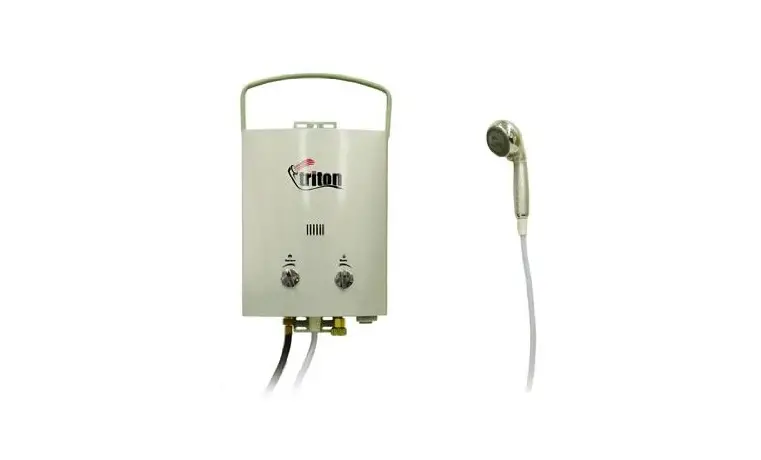 This compact tankless water heater is fueled by propane gas and uses two D cell batteries for ignition. The big handle makes it easy to carry, and the screw holes are easy to reach with a screwdriver for hanging it on a wall. It also comes with a stand and is convenient to bring just about anywhere.
This compact tankless water heater is fueled by propane gas and uses two D cell batteries for ignition. The big handle makes it easy to carry, and the screw holes are easy to reach with a screwdriver for hanging it on a wall. It also comes with a stand and is convenient to bring just about anywhere.
The water lines use ½” NPT fittings, and an adapter for a garden hose is included in the box. Thankfully, a shower head and hose are also included, but there is no gas regulator. What is missing is a drain plug that can empty the unit easily when not in use. It is disappointing, as this also serves as freeze protection when using a heater during the winter.
With your water and gas are ready to go, you will need a starting pressure of about 25 psi for the burners to ignite, and a water pump is necessary for stagnant water sources. Its maximum pressure of 80 psi is lower than other similarly- sized heaters. There is no thermostat either, and while it has no problem producing hot water immediately, you have no idea how hot it is going to be.
When your hot water gets going, you only have to watch for wind since the burners easily go off in gusty situations. You have 20 minutes of continuous flow, but you can’t bypass the timer by restarting the unit as with other models on this list.
PROS
- Compact and comes with a handle and stand
- A shower head, hose, and adapters come in the box
CONS
- No gas regulator in the box
- Maximum pressure of 80 psi is lower than similar heaters
- No thermostat
- Lacks a drain plug for freeze protection
- Time limit for hot water can’t be reset even when restarting the unit
This is hardly a comprehensive list, of course. Instead, it offers some of my favorites. There are plenty of other great tankless water heaters out there, and it may well be that the water heater that fits your RV’s space and your needs best is not included above. That’s okay. Simply remember to do your research, read reviews, and ask questions as needed.
When you know what you’re looking for, it’s much easier to find it, and that’s especially true with tankless water heaters, so make sure to do your homework.
When you do find the right unit, remember to get professional help. There’s nothing worse than having a great water heater not work because you screwed up the install.
I hope this list was helpful, and if you have any questions, just ask!


